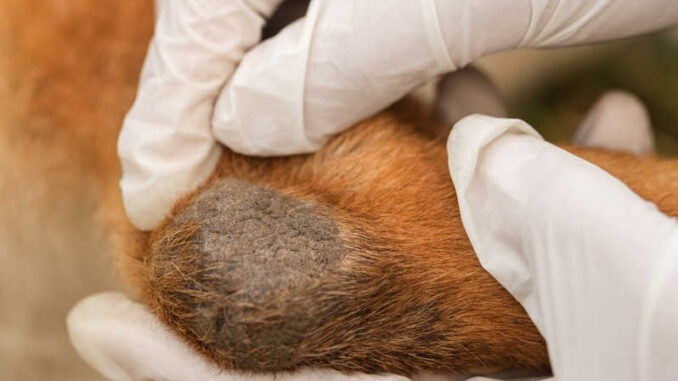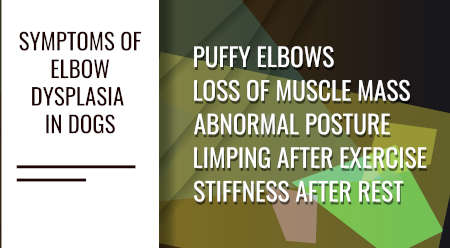
This article was updated on September 4th, 2023
As a general practice veterinarian in small animal medicine, I commonly see dogs present with front leg limping or lameness. There are numerous causes to be considered, but often the problem is found in the elbow. The elbow joint in the dog is the joint between the humerus and the radius/ulna, just as it is in humans. Elbow disease can typically be divided into developmental, traumatic, and degenerative causes.
Overview of elbow conditions in dogs
1. Developmental Elbow Issues in Dogs:
Developmental joint abnormalities typically affect medium to large breed dogs while they are growing. Any joint may be affected, but the elbow is a common site for issues.
There are three developmental joint issues that are medically referred to under the umbrella complex of “elbow dysplasia.” These include a fragmented medial coronoid process (FMCP), an ununited anconeal process (UAP), and osteochondritis dissecans (OCD). These are three distinctly different disease conditions and typically any one dog does not present with all three; however, being affected by any one of them will lead to the diagnosis of elbow dysplasia.
- Fragmented Medial Coronoid Process -FMCP is classified as a developmental defect of the dog’s coronoid process. These are two small pieces of bone located on either side of the ulna at its end inside the elbow joint. If affected by FMCP, one of the coronoid processes will have a small separation that separates it from the rest of the bone. This condition leads to elbow pain for the dog.
- Ununited Anconeal Process – UAP involves a small part of the ulna found along the backside of the bone, where it enters the elbow joint. In young dogs, this piece of the bone is attached to the ulna via a growth plate. As the pet ages, the growth plate should close and the anconeal process should fuse to the ulna. This typically occurs between five and six months of age. In UAP, the anconeal process fails to fuse to the rest of the ulna. This failure leads to pain and discomfort for the dog.
- Osteochondritis Dissecans- OCD is a disorder of the cartilage within the elbow joint. It is an inflammatory condition which results when there is a defect in the cartilage, causing it to separate from the underlying bone. This condition also leads to elbow pain in affected dogs.

Treatment of elbow dysplasia in dogs typically involves orthopedic surgery. Your veterinarian will likely refer you and your dog to an orthopedic surgeon to address the issue.
2. Traumatic Conditions:
- Elbow fractures – Elbow fractures can occur in any age or size dog, and are the result of trauma. Jumping or falling out of an owner’s arms to the floor is a common cause in small breed dogs, while larger dogs tend to fracture their elbows when jumping or falling out of vehicles or off of porches, etc. Certain predisposing conditions, such as bone cancer and incomplete ossification of the humeral condyles, can make the elbow more likely to fracture. An elbow fracture is an extremely painful injury and will need emergency veterinary care.
Treatment of elbow fractures will often involve surgery to stabilize the fracture with plates, pins, or screws. Joint fractures are rarely able to be treated with conservative management such as pain medications and splinting.
3. Degenerative Conditions:
- Elbow osteoarthritis– Osteoarthritis is a degenerative condition of joints often blamed on age and overuse of the joint. In dogs, osteoarthritis of the elbow is most commonly a sequela of predisposing elbow dysplasia from the dog’s younger years. The joint loses its protective cartilage and undergoes degenerative changes to the bones.
Treatment of elbow osteoarthritis in dogs may involve rest, pain medications, joint supplements, weight loss, physical therapy and conditioning, and possible surgery.
Signs of Elbow Issues in Dogs
- Developmental Elbow Disease-Typically, a young dog with developing elbow dysplasia will begin to show mild front leg lameness after strenuous activity such as running and playing. The condition most commonly starts to affect the dog in its first year of life. Untreated, the lameness progresses and begins to be apparent more often.
- Traumatic Elbow Disease- A traumatic injury of the elbow typically appears suddenly and often after a known trauma. These dogs are very painful and are likely not able to bear any weight on the affected limb. Post-injury, the joint will likely swell in the area of the fracture.
- Degenerative Elbow Disease- The lameness and pain associated with degenerative elbow conditions typically has a slower and more insidious onset. Owners may notice the dog getting up from a lying down position with difficulty or having a mild limp after vigorous exercise. As the condition worsens, the lameness becomes more pronounced and affects the dog more often.
Regardless of the cause, elbow disease is painful to the dog and should be addressed by a veterinarian as soon as possible.
Which Dogs Are at Risk?
Developmental elbow issues most typically affect large breeds such as the Bernese Mountain Dog, Bearded Collie, German Shepherd, Labrador and Golden Retrievers, Rottweilers, Newfoundlands, and Great Danes. This is an inherited genetic condition and can most often not be prevented, though research suggests that these large breed dogs need to be fed a diet with appropriate amounts of calcium, phosphorus, and protein as puppies to avoid further issues.
All dogs are at risk of traumatic elbow issues, but care should be taken to avoid such injuries. Small dogs should never purposefully be dropped to the ground from the arms and dogs should be encouraged to avoid excessive or high jumps from cars or porches.
Degenerative elbow issues affect mostly older dogs and affect large and medium breeds more frequently. Addressing elbow dysplasia when the dog is young, avoiding repeated joint trauma throughout their lives, and addressing arthritis with early intervention can all help alleviate elbow pain in dogs.
Home Care for Dog Elbow Pain
If your dog is limping, they are in pain. In the case of a traumatic injury, such as a suspected fracture, the dog needs to be taken to a veterinarian immediately. If the dog has a mild limp, it is reasonable to watch them for 24-48 hours to see if it is a mild injury that may improve. The dog should have its exercise restricted and allow the joint to heal. If the issues persist, the dog needs to be evaluated as soon as possible by a veterinarian.
Owners should never give over the counter (OTC) pain medications to their dogs for elbow pain. Many human non-steroidal anti-inflammatory medications such as ibuprofen and naproxen are toxic to dogs and administration can be fatal. Other OTC medications, even if marketed for dogs, such as aspirin, are ineffective pain relievers for this species and can lead to bleeding gastrointestinal ulcers even at low doses. Administering aspirin will also prohibit your veterinarian from prescribing appropriate pain medications as they cannot be mixed due to serious potential side effects.
When to Visit the Veterinarian
If your dog has a persistent limp or is not able to bear weight on the affected limb, veterinary care is needed. Often, some owners think that their limping dog is not in pain if they continue to act normally otherwise, but this is not the case. A dog that is limping is a dog in pain.
Frequently Asked Questions
- Can elbow conditions be prevented through breeding practices?
Many elbow conditions in dogs are genetic and heritable, so yes, responsible breeding is a very important aspect of controlling these painful issues in dogs.
- What is the typical age when elbow conditions manifest in dogs?
Developmental elbow disease typically manifests in large breed dogs in their first year of life, usually between five and ten months of age.
- How are elbow conditions diagnosed by veterinarians?
A veterinarian will begin with a thorough history and physical exam. The orthopedic exam will include a visual gait inspection, range of motion (ROM) testing, palpation, and a strength assessment. X-rays, magnetic resonance imaging, and computed tomography will typically follow the exam.
- Is surgery always necessary for elbow conditions?
Though some elbow conditions will require surgical correction, this is not the case for all elbow issues. Treatment will depend on the condition diagnosed and other factors such as age, activity, and the severity of the dog’s pain.
- Are there any home remedies for managing elbow pain in dogs?
At home, it is important to have your dog with an elbow condition rest to avoid further injury to the joint. Depending on the issue, your veterinarian may prescribe joint supplements, medications, and physical therapy exercises that can help alleviate your dog’s pain.
Disclaimer: This website's content is not a substitute for veterinary care. Always consult with your veterinarian for healthcare decisions. Read More.


Be the first to comment